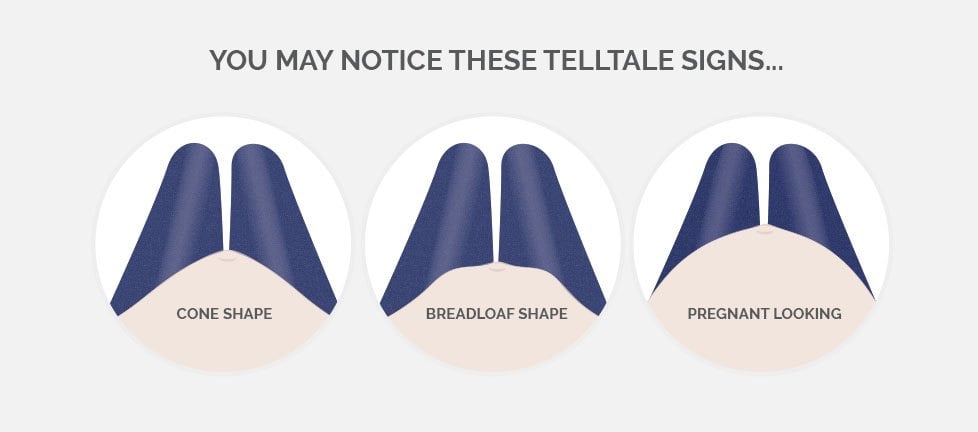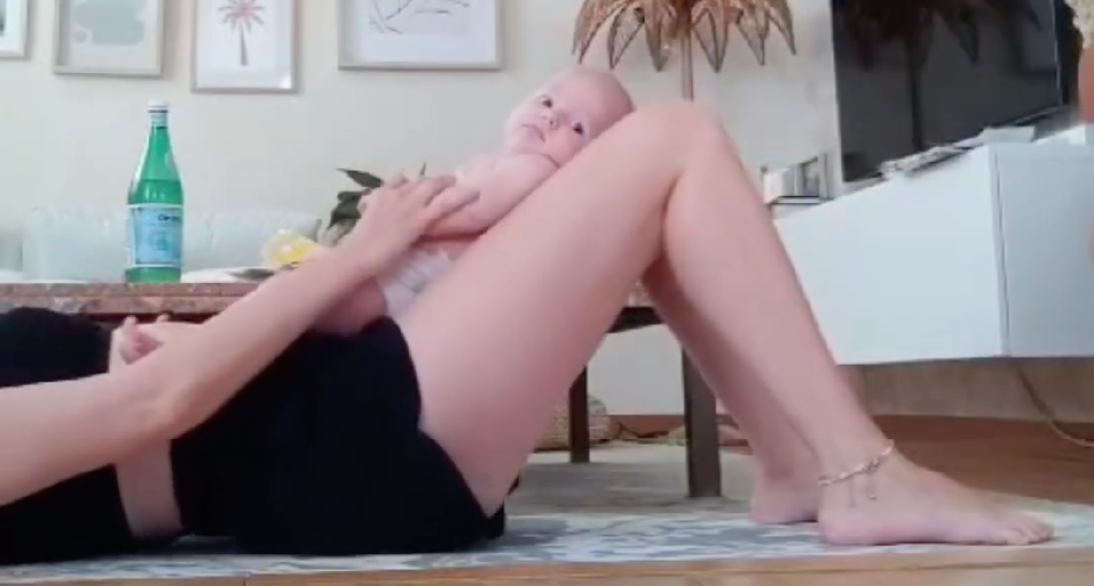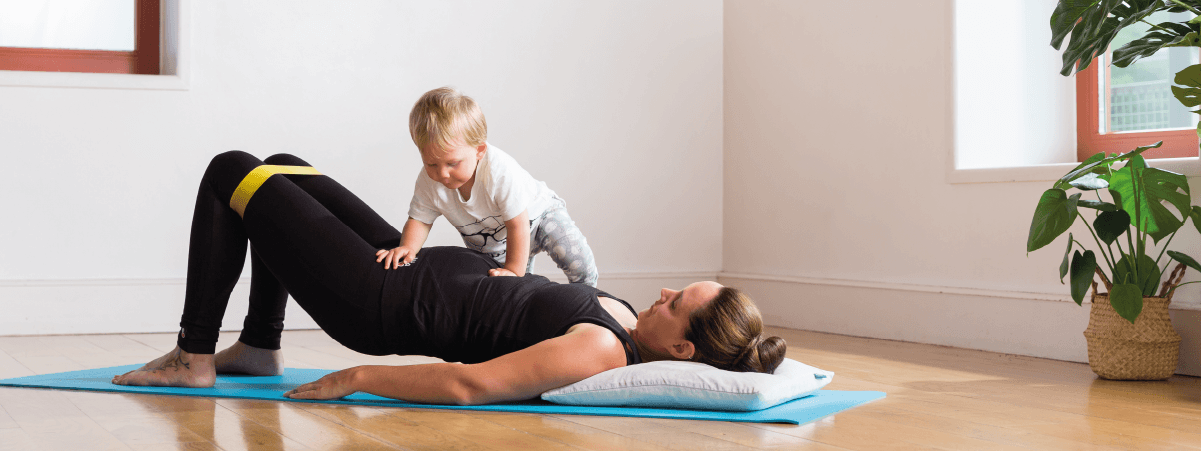Today we’re going to talk about diastasis recti exercises. In particular, we’ll attempt to answer your most common questions about abdominal exercises, such as planks and crunches.
We often hear that crunches, curl-ups or planks are not recommended for exercising with diastasis recti. Why? When and how can we do traditional ab exercising with diastasis recti? And what should we do instead of crunches?
We’ll also take a deeper look at what’s safe, what to avoid, the topic of functional movement, and some other common exercises, such as yoga, Pilates, and walking, that can be beneficial.
Not every exercise in pregnancy or postpartum is safe or effective in preventing or healing diastasis recti. If you’re looking for answers to some of the most commonly asked questions about exercising with diastasis recti, you’re in the right place!
Can I do ab exercises if I have Diastasis Recti?
Curling up from lying on your back engages and shortens the rectus — that’s the one that’s stretched out with the gap — so exercising to shorten it, if performed correctly, can be beneficial. It’s essential, though, to learn how to engage your core properly first when exercising with diastasis recti.
Standard crunches, sit-ups and planks are typically not recommended with diastasis recti, but that’s not a hard and fast rule.
That recommendation is because, rather than strengthening your core, doing these exercises with your abdominal split without properly engaging your core will increase intra-abdominal pressure. That can cause the pressure from within to push your organs outwards, against or through the gap, and/or downwards onto your pelvic floor. Not really where you want your organs forcefully heading!
So, before you start crunching away, you’ll need to reestablish function again with foundational exercises. And always listen to your body before, during, and after introducing ab exercises into your postpartum or pregnancy fitness routine.
Why are planks or crunches often not recommended?
Standard crunches, sit-ups or full planks are often not recommended for exercising with diastasis recti.
This is because the way a crunch is usually performed can increase intra-abdominal pressure. This means pressure inside that pushes your organs outwards, against or through the gap, and/or downwards onto your pelvic floor i.e. directions you don’t want your organs forcefully heading.
These exercise movements place excess load on the front of your abs and the gap.

You can see what you’re training your abs to do if you look straight down as you curl up: a cone shape, bread-loaf shape or a pregnant-looking belly.
These may be signs of diastasis recti, or that your core is not functioning optimally, and not the effect you’re trying to achieve.
So, many experts recommend eliminating these movements when exercising with diastasis recti. At least until the core musculature (including the pelvic floor) is restored and strong enough to withstand the movement.
We know you need to build the foundations of a restored, functional and strong core first.
Exercising with diastasis recti – building the foundations
Crunches, planks or heavy lifting are not bad or taboo exercises. No movements are. But it’s essential to build the foundations of core and pelvic floor function first, so that you can do them safely.
Diastasis recti is a gap between the muscles at the front of your abs. A small-ish gap may not be a problem at all, and you can have a strong functional core with a small gap. Watch the video on how to check for symptoms of diastasis recti. You may see bulging or doming, and you may feel like you’re ‘falling out at the front’ when performing certain movements or exercises.
So before you train your abs hard, you want to ensure the deeper abdominal muscles are actually recruiting (meaning… ‘kicking in’ and working). These muscles are the Transverse, the Inferior and External Obliques, the Rectus Abdominis, along with the muscles of your pelvic floor.
This is a vital phase of mind-to-muscle reconnection. Learning to recruit and engage the right muscles, first in isolation and then as a unit, must come first. That’s what the MUTU System program is designed to do.
Introducing crunches and other ab exercises back into your workouts
Done right, crunches may be fine with a diastasis recti, once you’ve established function again with foundational exercises.
Supine spinal flexion (that means curling up from lying on your back) engages and shortens the ‘six-pack’ abdominal muscle or Rectus. The one that’s stretched out, with the gap. Exercising to shorten it, if performed correctly, can be a good thing.
And anyway, bending forward like this is a perfectly useful human, functional movement! We sometimes need to do it, and we may want to do this type of ab exercises.
Safe ab exercising with diastasis recti
To perform a curl or crunch, keep the range of movement tiny at first.
That means don’t lift your head and shoulders very high off the ground – there is no muscular benefit to curling right up anyway. And keep the levers short – so knees bent up, feet flat on the floor.
Inhale fully with your head and shoulders completely relaxed on the floor. Then exhale slowly and focus on gently engaging your abdominal and pelvic floor muscles as you lift your head and shoulders just off the floor. Relax completely back down on the inhale. Watch for doming, straining and be mindful of how your pelvic floor feels.
Remember that crunches with straight legs, outstretched arms, raised legs or any adjustment that increases the load will increase the strain. Avoid these progressions until your core is fully healed and restored.
Want to start progressing a plank?
Start on all fours, and gradually shimmy your knees back, keeping your shoulders over your hands. This way, you gradually increase the lever, or load, on your abs. If you start to shake, feel like you’re falling out at the front, then thats your limit for now. Bring your knees back in a little. Stay there for a while and try again next time.
What to watch out for when exercising with diastasis recti
First, don’t hold your breath. This is common when doing ab exercises, even if you don’t know you’re doing it! Breath-holding builds up pressure and may cause your stomach to pooch or bulge out and your organs to bear down.
Often your hip flexors and lower back are taking the strain in a curl-up movement. This is especially an issue if you restrain your feet when crunching. The muscles you intend to target are not recruiting at all, whilst the diastasis gap could be widening further.
If you feel or see the following, stop, or back up to an easier version. Don’t ‘push through’ shaking, pain or any of these signs. They are your body’s clear signals that you’re not ready for this stage of the movement just yet.
Warning signs to stop
- Bulging or doming anywhere on your abdomen when you do any exercise
- Bulging in or from your vagina or rectum, or any feeling of heaviness or ‘bearing down’
- Pain – In your back, pelvis, abdomen, hips or leg
- Leaking urine or feces when you sneeze, laugh or cough; or leaking as you’re rushing to the toilet
So be sure to gauge whether you can maintain the tension at the front of your abs and in your pelvic floor. If you’re not sure, either have a Pelvic Health Physical Therapist check your technique, OR refrain from these moves for now until you know your core function is restored and you can engage the muscles correctly.
Otherwise, you could do more harm than good. It is preferable and much safer to find alternatives with techniques and patterns that have less potential to harm.
Most important: The movement is not a bad movement. You just need to be sure you’re getting it right, and that your body is ready for it.
What is functional movement, and should this be part of my recovery program?
Sometimes, in conversations about fitness and recovery, the idea that functional movement can be the best place to start gets lost in the talk of reps, weight, and speed.
Evolutionary biologist Daniel E. Lieberman is an advocate of functional movement. He notes,
“Humans evolved to move. We evolved to be physically active. But exercise is a special kind of physical activity. It’s voluntary physical activity for the sake of health and fitness. Until recently, nobody did that.”
When you start to feel like you’re being lazy for not fitting in a workout, especially after just having a baby, know that your body is hardwired not to want to exercise in the first place!
However, keep in mind that your body was designed to move.
Foundational movements to heal diastasis recti
In terms of healing diastasis recti, beyond just wanting to tighten up that dreaded “mommy belly,” it’s about restoring core movement for daily function. Because of this, functional movement, when done correctly, can be significant in closing your diastasis recti.
The seven human functional movements are:
- Squat
- Bend
- Lunge
- Core
- Push
- Pull
- Cyclical
Some examples of getting in functional movement are: walking, squatting, glute bridges, hip circles, and arm swings. Lieberman reminds us that beyond just health and looks, movement has always been a part of social development, and we’re more likely to stick with it if it’s fun and builds community.
Join a new mums walking group, take a postpartum yoga class, and dance around the house. It all counts. Plus, you have the MUTU community right there with you when you join the app.
Is it okay to do yoga with diastasis recti?
Yoga is often seen as the go-to workout for pregnancy and postpartum, but not every yoga program is created with the mom body in mind. There are some yoga positions to avoid with diastasis recti, and others that may be beneficial as part of an overall routine.
Some yoga postures to avoid with diastasis recti:
- Cobra
- Upward dog
- Sphinx
- Bridge
- Wheel or full backbend
- Table
Generally, yoga poses which involve backwards bending, deep twisting, or abdominal flexion (rather than engagement) might make diastasis recti worse.
If you are participating in a yoga class, be sure to tell your instructor if you have diabetes (DR) or are more than 12 weeks pregnant, so they can help you make the proper adjustments.
Can I do pilates if I have diastasis recti?
Like yoga or crunches, and many other traditional exercises, some Pilates might make diastasis recti worse, but with modifications, it can be beneficial.
Pilates is very focused on the core muscles, so a qualified instructor who is knowledgeable about diastasis recti limitations might be a great source of help for you in healing.
Some diastasis-safe modifications involve not lifting both feet or arms off the ground, using props to prevent core crunching, and removing deep twists. Make sure to talk to your instructor if you want to try pilates while healing DR.
Is walking okay to do with diastasis recti?
Walking is a FANTASTIC exercise when healing diastasis recti! It’s one of the foundational movements. Most major clinical advisory boards recommend all postpartum parents go for a ten-minute walk several times a week as soon as they feel ready after birth.
While walking, try practising proper posture and deep breathing, too. This will help you safely engage your core, reconnect with the muscles in your torso and pelvic floor, and help you move towards gradually adding more exercise to your postpartum fitness routine.
Does diastasis recti heal on its own?
In some cases, it will. This depends on many factors, including how severe your abdominal split might be. Typically, if it heals on its own, it will do so within the first few months after birth.
Otherwise, it will likely take some effort to heal. The good news is, it’s never too late to close your diastasis recti gap! MUTU has had grandmothers use the program to heal their diastasis recti, even.
It’s important to remember that just because you hit that eight-week mark, or your little one has just turned eighteen, starting slowly and methodically will return more healing and strength than going hard and fast with ab workouts, which might just strain your core more.
Learn more about how MUTU helps moms all over the world heal their diastasis recti anytime and at their own pace.
About the author: Wendy Powell is a globally recognized voice and leader in pregnancy and postpartum recovery, empowering women to move through their motherhood journey with confidence. She inspires with her personal story and the reasons for creating MUTU. Wendy is an expert in pregnancy and postnatal exercise, function and recovery, as well as mental health strategies that build dignity and self-esteem.
Working with the NHS and experts in women’s pelvic health, Wendy and MUTU are known and recommended by Doctors, Midwives, Specialist Women’s Health Physical Therapists and Surgeons around the world.
Resource updated: April 2023.









